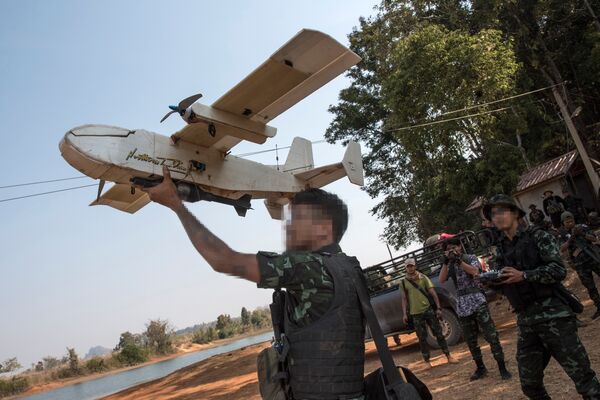
A resistance attack on Myanmar's administrative capital Naypyidaw on 4 April used domestically produced 3D-printed UAVs such as the aircraft depicted in this 2023 photo. This UAV, which appears to be similar to the UAVs used during the 4 April attack, carries a 2 kg 60 mm mortar bomb. (Thierry Falise/LightRocket via Getty Images)
An attack on Myanmar's administrative capital by resistance forces using unmanned aerial vehicles (UAVs) was part of the opposition National Unity Group's (NUG's) efforts to co-ordinate UAV operations against the military junta, an NUG spokesperson said.
Domestically produced UAVs struck at least three locations across the administrative capital, Naypyidaw, on 4 April, according to the NUG's Ministry of Defence (NUG-MoD). Janes assesses that this is the first attack of this kind on Naypyidaw.
U Kyaw Zaw, spokesperson for the Office of the President of the NUG, told Janes on 8 April that 30 UAVs were “used to penetrate the junta's air defence” at Naypyidaw. The UAVs attacked the headquarters of the ruling military government (or the State Administration Council [SAC]), Alar Air Base (also known as Ela), and the home of the SAC chairman, Senior General Min Aung Hlaing, the spokesperson added.
Alar Air Base is located next to Naypyidaw International Airport and hosts several high-value air assets of the Myanmar Air Force (Tatmadaw Lay). These include newly acquired Sukhoi Su-30SME multirole combat aircraft, plus transport aircraft, including two Fokker 70 narrow-bodied airliners used for VIP transport.
“The attack was part of Project Skywalk,” Kyaw Zaw said. “Our core objectives for Project Skywalk are to be able to unite UAV forces under one command, to co-operate and collaborate on high technologies, and to be able to [obtain and deploy] tactical UAVs for the operations.”
Looking to read the full article?
Gain unlimited access to Janes news and more...







